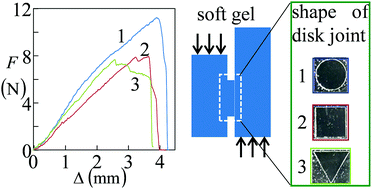The effect of shape on the fracture of a soft elastic gel subjected to shear load†
Abstract
For brittle solids, the fracture energy is the energy required to create a unit area of new surface through the process of division. For crosslinked materials, it is a function of the intrinsic properties like crosslinking density and bond strength of the crosslinks. Here we show that the energy released due to fracture can depend also on the shape of a joint made of this material. Our experiment involves two gel blocks connected via a thin gel disk. The disk is formed into different regular and exotic shapes, but with identical areas of cross-section. When one of the blocks is sheared with respect to the other, the shear load increases with vertical displacement, eventually causing a fracture at a threshold load. The maximum fracture load is different for different disks and among different regularly shaped disks, it is at a maximum for pentagon and hexagon shapes. The fracture energy release rate of the joint depends also on the aspect ratio (height/width) of the shapes. Our experiments also throw light on possible reasons for such a dependence on the shape of the joints.



 Please wait while we load your content...
Please wait while we load your content...